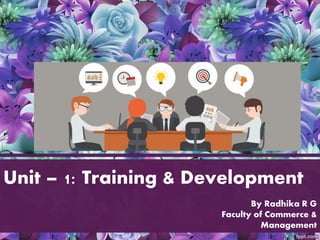
Training & Development in Organizations
- 1. Unit – 1: Training & Development By Radhika R G Faculty of Commerce & Management
- 2. INTRODUCTION: Earlier humans used to transfer knowledge with the help of sign and actions to others, but due to industrial revolution different types of training comes into existence which helps the workers for operations of machines. Today because of rapid technological changes and improvement, there is need for higher skills and knowledge in many areas and therefore training and development has been the most important organizational activity.
- 3. CONT. Before some years employees were considered a cost to be controlled. But now it is considered as an asset which can be developed so overall organizational development can be possible which will give high rate of profit to the companies. Training and development increases the abilities of employees to meet the new competitive standards of market. Its impact can be measured at several levels- the economy, the organization and the employee.
- 4. CONT. The Indian companies that have made significant investments in their human resources have enjoyed increased economic success. Therefore, training and development is important to cope up with the challenges in the changing environment so that organization can remain in business. Training and development programs are needed for organizations of all size, all types, all levels and at all areas.
- 5. TRAINING & DEVELOPMENT: According to H. John Bernardin “training is any attempt to improve employee performance on a currently held job or one related to it”. Nadler has stressed the difference between ‘training’ which is concerned with present jobs, and ‘development’ which is concerned with future jobs. Training is an educational process. It provides information to the people and increases knowledge and skills and can help them improve their effectiveness at work.
- 6. CONT. Training can be given to individuals and groups. Content of trainings increases skill development and improve behavior at workplace. Training and development is one of the key HR functions. Most organizations look at training and development as an integral part of the human resource development activity. Many organizations have mandated training hours per year for employees keeping in consideration the fact that technology is deskilling the employees at a very fast rate.
- 7. NATURE OF TRAINING & DEVELOPMENT: 1. Better Performance 2. Economy in Training Costs 3. Elimination of Wastage: 4. Less Supervision 5. Less Accidents 6. Team spirit 7. Organization Culture 8. Quality 9.Healthy work environment 10. Profitability
- 8. OBJECTIVES OF T & D: 1. To provide new employees the basic knowledge and skill they need for performing their work. 2. To ensure that each employee has capabilities to perform their duties. 3. To assist employees to function more effectively in their present positions by providing them updated information and techniques and developing the skills that they will need to do their job.
- 9. CONT. 4. To help the employee develop as an individual so that the organization can utilize the maximum potential of its employees. 5. To prepare employees for high level responsibility. 6. To reduce supervision wastage and accidents. 7. To develop inter-personal relation. 8. To reduce employee turnover and absenteeism. 9. To increase motivation and morale of employees.
- 10. Management Development: Management Development is best described as the process from which managers learn and improve their skills not only to benefit themselves but also their employing organizations. Management development is the structured process by which managers enhance their skills, competencies and knowledge, via formal or informal learning methods, to the benefit of both individual and organizational performance.
- 11. Objectives of Management Development: 1. To provide adequate leaders. 2. To increase the efficiency of performance of existing executives. 3. To serve as a means of control in operations. 4. To train managers for higher assignment who show potential for growth greater than those of their colleagues. 5. To prepare them for adaptation to changes, environmental, ideological and technological. 6. To develop unity of purpose and improve morale
- 12. TRAINING & DEVELOPMENT METHODS: There are two types of methods i.e. On-the job training method and Off-the job training method. The decision whether the training should be carried out On or Off the job cannot be made randomly. A judgment has to be made as to which method is more likely to meet the required objectives.
- 13. A) On-the job training method: On-the job training method generally takes place in the normal working situation. This refers to the methods of training in which a person learns a job by actually performing it. A person works on a job and learns and develops skill at the same time. 1. Apprentice 4. Understudy Position 2. Job Rotation 5. Management Participation 3. Coaching
- 14. B) Off-the job training method: 1. Lectures 2. Group Discussion method 3. Case Study 4. Incident Process method 5. Simulate 6. Role Plays 7. Business Game 8. Conference method 9. Sensitivity Training 10. Vestibule Training method
- 15. PROCESS OF TRAINING AND DEVELOPMENT: 1. Problem Identification: 2. Designing the need analysis: 3. Data collection: 4. Data analysis: 5. Providing feedback: 6. Developing action plan:
